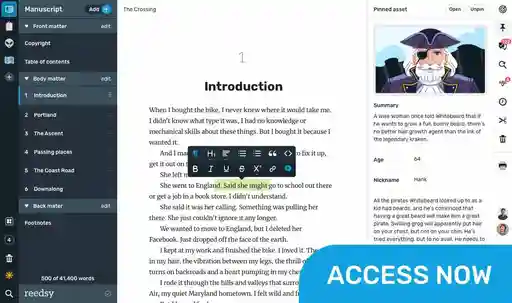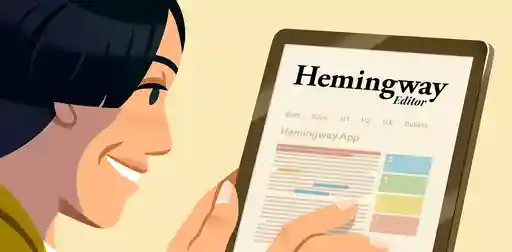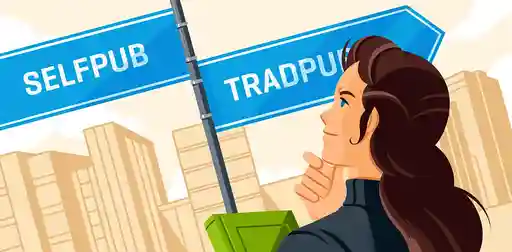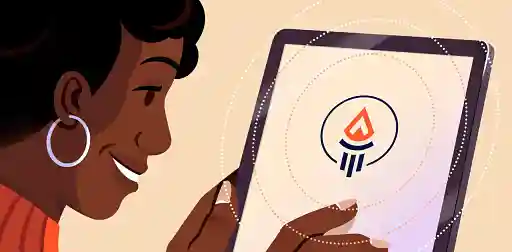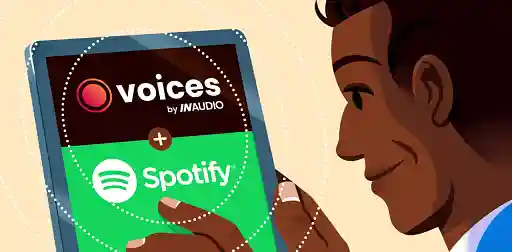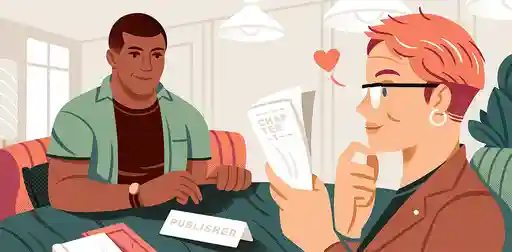Blog • Understanding Publishing
Last updated on Oct 15, 2025
Lulu Publishing Review: READ THIS Before You Use Them!
Martin Cavannagh
Head of Content at Reedsy, Martin has spent over eight years helping writers turn their ambitions into reality. As a voice in the indie publishing space, he has written for a number of outlets and spoken at conferences, including the 2024 Writers Summit at the London Book Fair.
View profile →Over the last two decades, Lulu has become one of the biggest self-pub platforms in the business. Lulu publishing, or “Lulu Press” as the company is now called, offers both print-on-demand and distribution services for books. And they're a popular choice among self-publishing authors for POD — in terms of notoriety, Lulu is right up there with KDP Print, BookBaby, and the other major players in the print-on-demand apce.
However, Lulu has also acquired a negative reputation for taking substantial cuts of author royalties, forcing many authors to either price their books ridiculously high or to receive no royalties at all. This may leave today's authors wondering: is publishing through Lulu Press even worth it?
To help you make the final call, we've reviewed all their services here, complete with costs, quality levels, and comparisons to similar companies. If you just want the TL;DR, feel free to jump to the end via the table of contents. Otherwise, let's jump right into the review.
Print-on-demand service
Rating: 4/5 stars ⭐⭐⭐⭐
We'll start Lulu's claim to fame: their print-on-demand service for print books, photo books, comic books, and more. As an author printing a “typical” book with few images, you can choose from the following customization options:
- Interior — premium color, premium black & white, standard color, or standard black & white
- Paper type — 60# cream, 60# white, or 80# coated white
- Book binding — coil, hardcover, paperback, or linen wrap
- Cover finish — glossy or matte
Note that hardcover is only available for books of 20 pages or more, and saddle stitch is only available for pamphlets. So if you upload a short PDF just to test Lulu's options, you may see saddle stitch instead of hardcover, but this will change once you upload your actual book.
Q: What are the most common mistakes authors make when self-publishing?
Suggested answer
From my conversations with self-publishing authors, here are some points came up most frequently:
- Cover design - trying to do it yourself if you don't have an understanding of design principles (or skimping by paying someone peanuts). Whether we like it or not, everyone is judging everything and everyone. First impressions count and good (exceptional) design, attracts attention. I myself have been known to purchase books just because of a gorgeous cover (and hoping the story will be as good!).
- Formatting - poor formatting will absolutely degrade all your efforts. Subconsciously, readers shouldn't be drawn to the layout. An exceptional one doesn't stand out (by way of - "There's something "off" with this layout"), and allows the reader to focus on the book content. Excellent formatting reflects an excellent product.
- Marketing - clearly defining who your target audience is, means you have clarity when it comes to creating your marketing content. It helps you market specifically to those most likely to purchase your book/s and develop a loyal following. Writing your book was one part of it. The marketing is as important to get it out into the world and it requires effort and a good understanding of what your specific book needs, so that it can garner the right attention.
- Audience - ignoring your audience and not engaging with them (or hearing their feedback), can be detrimental. They're your main source of importance when it comes to your reach. Truly understanding who they are (as above in marketing - your target audience), is crucial. They will want to engage with you and will reciprocate with loyalty.
- Procrastination and Perfectionism - this is probably one of the greatest issues we face (across humanity to be honest), and it's also a natural part of being human, that we must overcome. Learning how to optimize your time, carving out when you're most productive and sticking to it daily, and tracking when and how often you show up, creates your lifelong "good" habit. We want to weed out the bad habits that stop us from creating the work. Waiting for "the right time" is a fallacy and something that will blindly rob you of precious days, months and sometimes years. Show up for your future self now and develop the habits (over goals), that will compound over time and create the results needed. It's the actual action-taking that gives you clarity. You just need to start and keep going. Know one gets it right in the beginning. Just don't quit on yourself.
- Editing - after your hard work of bringing your book to life, this is an extremely important part of the writing process. We are so close to the work that we can easily miss what is right in front of us. A professional editor can whip you into shape and saving you time, effort and will elevate the quality exponentially.
The way to success is to never give up. Remember why you are doing it and enjoy the process!
Leoni is available to hire on Reedsy ⏺
Something I have seen quite a lot lately in the self-publishing world: trying to do everything by yourself. Thinking that you just need Photoshop to make a cover, spell-checking software to edit, a dictionary and a bit of knowledge to translate. Never underestimate the value of a human professional who has spent years studying and then honing their skills. There is more to translation than substituting one word with another, just as there is more to a cover than a bunch of drawings and a title.
Find the right professional for you and your project, and work closely with them; you won't regret the expense, I promise. Also, yes, some types of stories and tropes are very popular right now, and those seem like a safe bet, as far as marketing and selling go - but likely there are a lot of similar books out already. In traditional publishing, variety is sorely lacking, because a tried and tested product seems safer; let's avoid repeating that mistake. Write the story that's in your heart and then strategically find your niche audience. You'll find them starved for exactly your flavour of creativity.
Mariafelicia is available to hire on Reedsy ⏺
One of the most common mistakes I see with self-published authors is setting unrealistic timelines for their publishing journey. Many writers plan their schedule far too tightly and only reach out to professionals—whether editors, designers, or marketers—at the very last minute.
This creates unnecessary stress on both sides: the author feels rushed and overwhelmed, while the professionals either have to decline the project or take it on under less-than-ideal conditions. In the worst case, authors struggle to even find available professionals because their preferred timeline doesn’t allow for the necessary lead time. Many professionals book out months in advance, so it’s wise to plan at least four months ahead—and in many cases, even that may not be enough time.
It’s also important to remember: as self-publishers, you are free to set your own pace. Unlike in traditional publishing, there is usually no external deadline or audience impatiently waiting for the book—especially when it’s a debut. That pressure often comes only from a self-imposed timeline. Instead of rushing, it’s far wiser to take the time to do everything properly, work with professionals without stress, and then launch the book when it’s truly ready.
Publishing a professional-quality book requires space for collaboration, revisions, and creative breathing room. When timelines are compressed, the process becomes about “getting it done” rather than “getting it right,” which can ultimately compromise the quality of the finished book. A thoughtful, realistic schedule not only reduces stress but also ensures that every stage of the process—from editing to design—has the attention it deserves.
Sabrina is available to hire on Reedsy ⏺
One of the biggest traps authors fall into when self-publishing is thinking that the hard part ends once the book is written.
In reality, self-publishing is as much about production as it is about creativity, and overlooking that side can leave even the best manuscript looking unprofessional.
I’ve seen too many writers skip professional editing, try to design their own cover, or leave marketing as an afterthought, and the results are usually disappointing. But just as important, and often less discussed, are the mistakes around the actual printing and publishing process. Authors frequently go with the first printer they find rather than getting at least three quotes, which is a sure way to overpay.
Others don’t ask whether VAT will be added on top of the quoted price, only to discover the true cost later.
Perhaps the most heartbreaking mistake is not asking to see samples of the paper and materials being used; the author waits excitedly for their book to arrive, only to be handed a flimsy volume on cheap stock that feels nothing like the work they poured their heart into.
The truth is, self-publishing is about producing a product as much as sharing a story. Taking the time to ask questions, compare options, and insist on seeing exactly what you’ll be paying for can mean the difference between a book that looks like an amateur project and one you’re genuinely proud to hold in your hands and which reflects the hard work you have put in as well as the hopes, naturally enough, of your client to hold a book in their hands which is a quality item.
Edward is available to hire on Reedsy ⏺
I've read a fair number of self-published books, and one thing I have noticed is that an unprofessional interior book design does impact my reading experience.
Interior book design is about all that invisible work that makes a book visually pleasant to read. If the lines break poorly, if the font is too big or too small, if the line spacing is too tight or too loose, if the font selection is one that's difficult on the eyes, especially after reading for a long time--all of this will subtly make your reader tired while reading, and, perhaps subconsciously, less likely to enjoy reading your book. They might not even know why! And by the end, they may be left with this feeling that they didn't want to pick up the book to read it as much as they have other books, which is not a feeling you want your readers to have, especially for something so easily fixable.
A well typeset book is unnoticeable. That's the point! Your reader doesn't notice the words on the page. Instead, they glide over them, immersed in the story. But a poorly typeset book stands out. Your reader's attention is pulled from the story again and again because the words are too squished together to read easily, or because there was one dangling line all by itself on the last page of a chapter and that looked odd, or because the font for the text messages was inconsistently applied.
Interior book design is an important part of the publishing process that I think a lot of self-publishing authors overlook.
Emily is available to hire on Reedsy ⏺
Two mistakes I've encountered through my work with self-publishing authors are definitely common, but perhaps not super obvious at first thought.
Mistake #1: Hoping to ultimately publish with a traditional publisher, but self-publishing first as a means to “test things out.”
Self-publishing should be a conscious and very intentional choice that you make because the process appeals to you, not something you do as a test drive. Once it’s published, it’s published. In fact, as a former slush pile evaluator, I quickly learned that a previously-self-published submitted manuscript was often a no-go for the publisher I worked with. Why? Well, any self-published copies of the book that had been already sold are sales the publisher might have otherwise been able to count on — chances are, if you’ve self-published your book, you’ve already gotten all your friends and family to purchase a copy. Those are all opportunities for sales no longer open to the publisher. So, if you want to self-publish, that's great! But make sure that, whatever you decide on, you're making an intentional and conscious choice.
Mistake #2: Consider your use of copyrighted works and get permission!
This applies to nonfiction and fiction works alike: If you are including previously published content in your book, do your research and understand what may require permission to use. If you're including lengthy quotations or extracts from books, short quotations to open your book chapters (i.e., epigraphs), song lyrics (yes, even just one line of a song), poetry, or photographs/artwork, you will need to seek permission clearance from the copyright holder to legally include that content in nearly all cases. I can tell you, based on several years of experience in permissions editing, that the process of figuring out who the copyright holder is, applying for clearance, hearing back, and finalizing the clearance can take MONTHS. And you may not even be granted permission, after all that effort! It can also be very expensive — publishing companies and record labels especially will charge you per usage and based on the amount you've used. So, do your research, know the risks, and decide accordingly.
Lesley-anne is available to hire on Reedsy ⏺
The most common mistakes authors make when self-publishing are: 1) Not focus-group testing yout title and subtitle, Check with Amazon for duplicate titles, and ask friends/colleagues 2) Not obtaining at least 2 endorsements, for front and back cover. 3) Not creating a publisher name for themselves Amazon. If you publish under your personal Amazon account, the "publisher" will be listed as "independently published," which can erode credibility. Instead, set up your KDP account in the name of a publisher you invent. There are many more, like poorly-designed covers and interiors, but these are of the most overlooked.
Michael is available to hire on Reedsy ⏺
Common mistakes:
Unrealistic or distorted view of public interest (Harsh, I know.)
Family and friends aren't fans--neither are paid reviews. It is important to be as objective as possible when assessing your book's popularity. I say this because many indie and early-stage authors believe they need what NY Times BEst Selling authors need, and that can lead to a lot of wasted time and money.
Acting as your own publishing company
It may seem like creating a separate name as your "publishing company" but the reality is, you don't yet have a company. This can be misleading to actual publishers that may be interested or contribute to the mistake mentioned above. These days, authentically doing everything on your own is more appealing to readers and publishers than the "fake it 'til you make it" strategy.
Starting a blog
If you aren't ready to commit to a regular schedule or writing blogs in batches, you don't need a blog on your website. Focus more on a simple and clear website and point of sale, then drive traffic to it. A blog isn't going to get you traffic unless you treat the blog itself as a business of its own.
Chad is available to hire on Reedsy ⏺
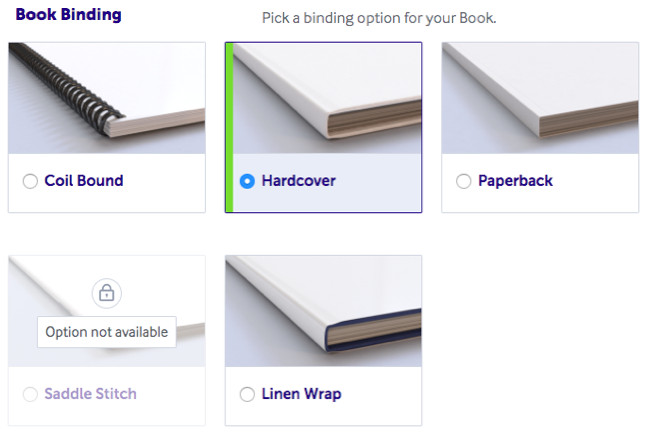
Speaking of which, while the upload process only takes a minute, you will have to spend some time formatting your book beforehand. Lulu has very specific requirements for PDFs, as outlined on this page.
Though formatting your PDF according to these rules isn't a deal-breaking hassle, it does make things more complex than users might anticipate! We'd say Lulu's POD setup process is easier to navigate than that of the notoriously tough IngramSpark, but more difficult than using KDP Print. This knocks the overall POD experience down from five stars to four.
In any case, make sure to read through all those requirements before uploading your PDF and finalizing your design choices, and preview your book in full to confirm everything looks good. Then you're ready to fill out the rest of your project details and place your order!
Looking for an easy, FREE way to format your book for publication? Reedsy Studio can help.
What about print quality and costs?
As you'll see once you finish designing your book, Lulu's printing costs depend on the materials you choose and the number of pages you have. For a 200-page book with B&W interior, lightweight pages, a paperback cover, and matte finish, Lulu estimates a print cost of $5.34 per unit:
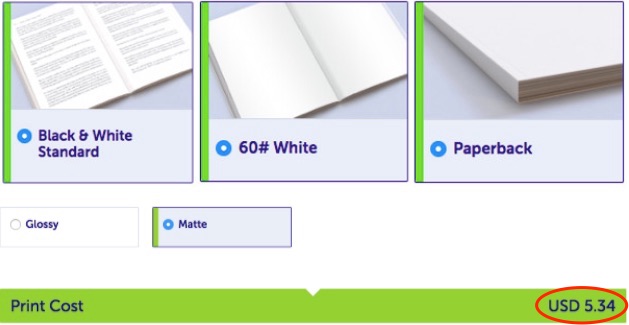
For reference, if you choose hardcover instead, the cost rises to $12.30 per unit. With hardcover binding AND premium color interior, the print cost inflates to a whopping $27.50 per unit. Check out the table below to see how these print costs compare to other POD companies!
Q: What are the most common mistakes authors make when pricing their self-published books, and how can they avoid them?
Suggested answer
A big mistake I see authors make is not thinking through how their pricing affects readers. If you price your book too high, you risk scaring people off. If it’s priced too low, readers might assume it’s not worth their time. Finding the right balance—what I like to call the “sweet spot”—is so important.
The best place to start is by looking at other books in your genre. What are they priced at? This gives you a good idea of what readers are willing to pay. Temporary promotions, like dropping your price to $0.99, can help boost visibility, but I don’t recommend staying there. It’s easy to get caught in a “race to the bottom,” where constant discounts make your book feel less valuable.
As your book gains credibility—through reviews, awards, or just word of mouth—you can raise your price to reflect that value. Pricing isn’t just about numbers; it’s about showing readers that your book is worth their time and money.
Jd is available to hire on Reedsy ⏺
The most common mistake authors make when pricing their self-publishing books is not pricing it so that they are covering all of their outlaid costs. Some authors only look at comparative titles in the marketplace and how they are priced. Indeed, this is an important step in figuring out what to price a book, but if you are not making a return on investment to at least to recoup your spend, not to mention a profit, then your list price is failing you.
Tara is available to hire on Reedsy ⏺
My answer, as usual, is based solely on Amazon, where 80-100% of sales happen for most authors.
1. Missing KDP's thresholds for Kindle
Amazon pays you 70% of the retail Kindle price - if the price is in the range $2.99 - $9.99.
If the price is lower than $2.99 or $10 and higher - you will receive only 35% in royalties.
Kindle book which is more expensive than $10 and below $29 has no economic justification from the self-publishing point of view.
2. The same price for the paperback and Kindle
Those are two distinct products. Kindle should be cheaper than paperback. There are no production or distribution costs involved for an eBook.
Plus, Amazon customers are trained to expect cheap and discounted stuff, especially for such a flagship category like Kindle books.
3. Pricing too low
This happens more with hard copies. In 2025, Amazon introduced new royalty structure: 50% royalties for books cheaper than $9.99, and 60% for $9.99+ books.
The trick is in fine print, as usual. Those percentages are counted after deducting the printing (and distribution) fee. So, when the same book costs $8 or $12, your royalties will be dramatically different. Let's say the printing cost is $3: in the $8 scenario you will get half of the five dollars; in the $12 scenario, you will receive 60% of nine dollars ($2.5 vs. $6).
Avoid the less-than-$9.99 price range, unless you have particularly good reason to price your book so low.
With Kindle there is a dramatic difference between $2.99 book and $2.49 book because of the thresholds mentioned in point #1 (about $2 vs. 87 cents).
Personally, I find only one price point below $2.99 worth trying: 99 cents. It is good for entry point of a series or for promotional purposes.
4. Pricing too high
It applies especially to Kindle format. First, because the royalties’ thresholds penalize higher prices. Second, because Kindle readers are cheap.
First-time authors think: "It's just $5, a price of the coffee, surely people will be willing to buy my book." They forget that they don't sell coffee, but eBooks. Amazon customers have millions of other titles free or priced incredibly low to choose from.
In case of paperbacks, it is more about the subject matter and length of the book. If you try to sell your 70-page novella for $20, good luck. Non-fiction books solving specific problems are more "justified" to cost more.
In the fiction genres the competition is fiercer. Readers have plenty of alternatives, so if you overdo your price, they may skip your book and pick your competitor’s book.
5. Pricing out of market
If you aren't a household name, you'd better accommodate to market's expectations. Don't price your debut novel, or poetry book, or children book $50 - it is just too expensive.
Don't price your business manual $0.99 - people will think it's so cheap because it's trash.
Michal is available to hire on Reedsy ⏺
Printing costs notwithstanding, most authors seem pretty satisfied with the production quality of Lulu-printed books. They report high-resolution covers, thick pages, and well-aligned text that doesn’t bleed through. Note that a few users have noted lower-quality materials and longer shipping times with large orders, especially around the holidays.
But overall, the printing side of Lulu’s business holds up. It's certainly as good as, if not better than, most other POD services in terms of the final product. However, if you're really committed to getting high-quality print books, you should consider investing in offset printing instead.
Lulu POD service vs. other POD services
Curious how Lulu stacks up to KDP Print, IngramSpark, BookBaby, and Blurb in terms of print-on-demand? Consult this table to compare their POD services on user friendliness, print costs, product quality, and more.
| Lulu | KDP Print |
Ingram Spark |
BookBaby | Blurb | |
| Ease of setup | Medium | Easy | Hard | Easy | Easy |
| Offers hardcover? | Yes | No | Yes | Yes | Yes |
| Print cost per unit (with basic design) | $5.34 | $4.35 | $4.71 | N/A | $5.67 |
| Volume discount? | Yes | No | Yes | No | Yes |
| Shipping time | Average | Fast | Fast | Average | Average |
| Quality of final product | Good | Fair | Fair | Good | Very good |
Print book distribution
Rating: 2/5 stars ⭐⭐
Now let’s talk print book distribution. Lulu distributes print books to Amazon, Barnes & Noble, the Ingram network, and more, including its own Lulu Bookstore. All in all, this global distribution service reaches over 40,000 retailers around the world. But Lulu's extensive distribution network comes at a (literal) price: lower royalties.
There seems to be a lot of confusion over Lulu Press royalties, so allow us to clear some things up. Lulu doesn’t “steal” royalties from authors, as some reviews claim. However, they do intentionally obscure their pricing model on pages like this, claiming you’ll receive “80% of profits” from your printed book.
When you get into the nitty-gritty of pricing your book, you’ll realize that “80% of profits” doesn’t mean 80% of your sales. Rather, it’s 80% of the amount left after print costs and distribution fees (taken by Amazon and other retailers). The other 20% goes to Lulu. Here's what that looks like:
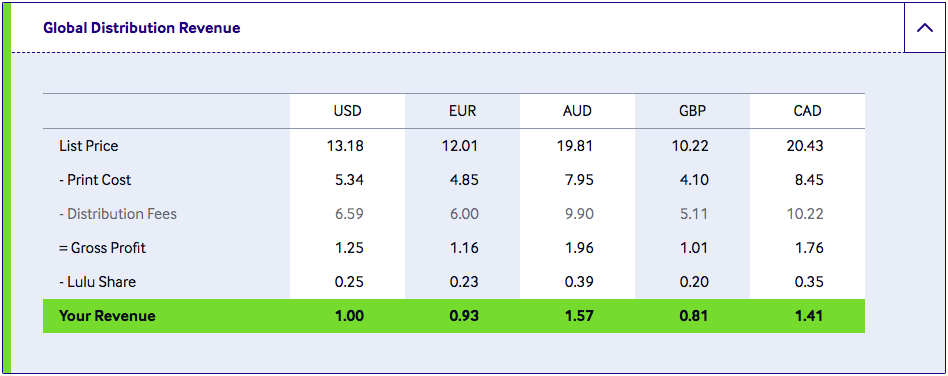
As a result, you’ll need to price your print book fairly high in order to make any money. For our 200-page paperback book, which is relatively short and made of basic materials, the list price to earn a single dollar per sale is $13.18 (see above). If we want to earn $5 per sale, the list price jumps up to $23.18, with the distribution fee increasing accordingly.
Q: What are the most effective ways for authors to begin monetizing their writing, particularly in the early stages of their career?
Suggested answer
At the beginning of your writing career, the best way to turn a profit is to be thoughtful and innovative when looking at your work.
Many new writers begin with self-publishing novellas or ebooks, which are inexpensive to produce and can be distributed to readers in rapid order.
Platforms like Smashwords or Kindle Direct Publishing permit the earning of royalties as well as developing a reader base.
Short stories appearing in literary magazines, anthologies, or contest publications also generate income and exposure.
Besides publishing, the majority of authors offer ancillary services—blogging, freelance, or ghostwriting—to generate a reliable flow of income and hone their writing skills.
Achievement in the beginning more likely comes from stability, reader engagement, and smart marketing: building a mailing list, establishing an internet presence, and cooperating with specialty communities relevant to your genre.
Money-making is never instant, but every action generates momentum toward a lucrative writing career.
John is available to hire on Reedsy ⏺
Take advantage of every single opportunity that comes your way in the beginning. Don't be too picky. If the front door is locked, go in the side door. Or find a window. I had great luck with blind queries in the beginning and that was before email, kids. I built many relationships that way, and most of all, keep believing in your talent, be agile, be diligent, and above all LEARN HOW TO SELL YOURSELF.
Bev is available to hire on Reedsy ⏺
If you are a non-fiction author you can use your book as a platform to get speaking engagements even before your book is published. Once it is published, ask the business you are speaking for to purchase books for each of the conference attendees and then include this purchase in your speaking "package."
Melody is available to hire on Reedsy ⏺
If by "best," we mean "fastest," then self-publishing is the way to go, since there're no gatekeepers, meaning no wait time. As soon as your book's done, you can get it up for sale. But if we mean best as in "long-term for your career," that becomes a fuzzier proposition because you need to weight the wait time, rejection, potential rewrites/edits, and possibility of never having something accepted inherent in traditional publishing against the prestige that still comes with making it into that world. It also depends what level of control you want for your work. You obviously get much more with self-publishing, but perhaps you'd benefit from the edit you might get from an editor at a legacy press. Lots of variables here, but my advice is always to be honest with yourself regarding your goals.
Legacy prestige is great and all—and, if it goes well, can be much more lucrative—but there's a lot to be said for having full control of your product.
Brett is available to hire on Reedsy ⏺
Another option is to distribute only to the Lulu Bookstore, which doesn’t incur any distribution fees. Still, you have to consider the negative impact of not listing your book on major retailers. You can promote your own Lulu listing, but nobody’s going to find it organically. On top of that, you can’t even run price promotions to attract readers, like you can on Amazon.
So why would anyone distribute through Lulu?
The key thing to remember is that you’re not really paying to “distribute through Lulu,” you’re paying to print with Lulu. And the printing and distribution plans are a package deal — it’s not like you can print with Lulu and then distribute through another company.
Also, to be fair, high distribution fees aren’t unique to Lulu. Other POD companies charge substantial “middleman fees” as well; for example, BookBaby charges a flat fee of $399. KDP Print, IngramSpark, and Blurb recoup the cost through book sales, same as Lulu does.
But no other major print-on-demand company takes quite as much as Lulu. BookBaby and Blurb don't have user bases nearly as large, and KDP Print and IngramSpark both offer better expanded distribution plans and royalty shares than Lulu. That’s not even accounting for the fact that you can use KDP Print to distribute directly to Amazon — a market that’s obviously much more valuable than the Lulu Bookstore.
Lulu distribution vs. other print distribution services
Want to see exactly how these companies' print distribution services stack up? Check out this table comparing their costs and retailer networks. (Note that the distribution fee here also includes company commission, e.g. Lulu's 20% of your “gross profit”.)
| Lulu | KDP Print | IngramSpark | BookBaby | Blurb | |
| Setup fee | None | None | $49 | $399 | None |
| Distribution fee (as % of list price) | 50-65% | 40% for Amazon, 60% for others | Author’s choice* | Taken from setup fee | Author’s choice* |
| Direct distribution network (no distribution fee applied) | Lulu Bookstore | Amazon | None (no Ingram bookstore) | BookBaby Bookshop | Blurb Bookstore |
| Expanded distribution networks | All major retailers | All major retailers | All major retailers | All major retailers | All major retailers |
*Both IngramSpark and Blurb let authors give wholesale discounts to retailers. This allows retailers to acquire print titles for less, which lowers the resulting distribution fees.
Ebook creation and distribution
Rating: 1/5 stars ⭐
We won’t mince words here: there’s very little point to creating and distributing an ebook through Lulu publishing. The only reason you might consider doing so is if you’re already distributing the print version through Lulu and want to streamline the process for yourself.
Q: What are the key red flags authors should look out for when approached by a vanity press?
Suggested answer
Spotting the red flags when dealing with a vanity press can save you a lot of headaches (and money!). Here are some key things to watch for:
- Upfront Fees: If they’re asking you to shell out big bucks to publish your work, it’s a major red flag. Legitimate publishers make money from selling books, not charging authors.
- Unrealistic Promises: Claims like “guaranteed bestseller” or “we’ll get you into every bookstore!” are major eye-roll territory. No one can promise that, and reputable publishers won’t even try.
- Accepting Anything: A real publisher is picky—they have to be since they invest in what they publish. If a press will take your book with zero hesitation (and no editing), chances are it’s more about your money than your talent.
- Vague Contracts or none at all: If the contract feels murky, confusing, or doesn’t make it clear what you’re getting and what rights you retain, that’s a huge red flag. Always know what you’re signing!
- Hidden Costs: Watch for surprise fees for “marketing,” “editing,” or “special services.” It’s a tactic used to squeeze more out of you once you’re already on the hook.
- Pushy Sales Tactics: If they’re coming at you hard with “limited-time offers” or pressuring you to sign fast, it’s a no-go. Legit publishers won’t need to convince you that hard.
- Shady Reputation: Do a quick online search. If you see lots of unhappy authors and stories of people feeling scammed, run the other way.
- Limited Distribution Claims: Be wary if their “distribution network” is mostly online listings without meaningful reach or promotion. Real publishers have genuine connections in the industry and established distribution channels.
- No Editing or Quality Control: If there’s no real editorial process or constructive input, it indicates they don’t care about the quality of your work—just about getting paid.
Bottom line is if it feels off or you’re seeing a bunch of these warning signs, trust your gut and dig deeper. Your work deserves better!
Eilidh is available to hire on Reedsy ⏺
I think we need to first distinguish between vanity presses and hybrid/independent publishers. There are legitimate publishers with a business model that includes an upfront payment from authors. This payment funds the production of the book, and then includes a royalty split in favor of the author, such as 70/30 or even 80/20.
Those are hybrid presses, which help keep much of the decision-making surrounding the book in the author's hands and provide a means for authors to benefit the most if the book sells well. They don't accept every book they are pitched, have quality standards that rival traditional publishers, and make money when more books are sold.
The hybrid model is different from a vanity press, which earns the bulk of its money from the pre-production and printing costs. Vanity presses rarely turn any author down who can pay for its services. Printing and design quality varies but you can still get a good-looking book from a vanity press, it will just be very expensive.
To know if you're dealing with a vanity press or a hybrid/independent press look for:
- Writers guidelines. Do they have any guidelines or will they publish anything?
- A sense of urgency. Vanity presses want to get you to commit and pay them money. This may lead to frequent emails, texts, and phone calls to inquire about the hold-up.
- Distribution details. Once your book is printed, how will the publisher get it into bookstores and, ultimately, readers? They should have a distribution partner, such as Simon & Schuster.
In addition to vanity presses, there are many, many scam operations that have cropped up offering to ghostwrite and publish your book for a couple thousand dollars. Be aware that you will likely get nothing, or next to nothing. Avoid these at all costs.
Scammers may have a legit-sounding company name but will lack any information about the founders and the team members who will be doing the work. They will feature gorgeous cover photos of books they never had anything do with producing, but which look impressive. They will feature "testimonials" and A+ Better Business Bureau (BBB) and TrustPilot ratings that are fake - type in the BBB and TrustPilot URLs yourself to check for the real reviews. And they, too, will hound you to sign on the dotted line and send them money.
If the deal being offered sounds too good to be true, it very likely is. Protect yourself.
But the reality is that few first-time authors will qualify for a traditional publishing deal that doesn't involve paying for production. This is because the Big 5 publishers are risk averse and want book deals from people who have huge platforms and social media follower counts. That is, they want to be almost assured that your book will be a bestseller, and few authors can guarantee that. Which is why hybrid publishing is a terrific alternative.
Marcia is available to hire on Reedsy ⏺
Unrealistic expectations. All vanity publishers can do is produce the physical book and get it onto sites like Amazon. They cannot guarantee any income from sales.
Andrew is available to hire on Reedsy ⏺
The easiest way to distinguish a scam publisher from a reputable hybrid publisher or self-publisher is PRICE. If a publishing firm quotes a fee of just a few thousand dollars for a service package that includes everything from copy editing, cover design, and layout to marketing and publicity—or even ghostwriting and developmental editing—you’re probably dealing with scammers. I know this from experience and from the fact that any single one of those services, when delivered by skilled and experienced professionals, usually costs more than a few thousand dollars. By contrast, the fees charged by the reputable hybrid publishers I know—companies with a track record of obtaining meaningful results for their authors—start in the $15,000 range. Several of my past clients made the mistake of opting for cut-rate vanity presses, and all of them came to regret it. When you hire a publisher that charges cut rates, you get cut-rate services in return.
Peter is available to hire on Reedsy ⏺
The fact that they're a vanity press is the only red flag you need. 😉 Seriously, though, I'd aim for either traditional publishing or full-on self-publishing. These companies who want you to go in on the costs are generally more trouble than they're worth. Caveat emptor.
Brett is available to hire on Reedsy ⏺
It's simple. If a "publisher" approaches you about "publishing" your work, and doesn't offer to write you a check, run away. Okay, that's a bit dramatic. But understand that a true publisher buys intellectual property from creators, Some authors choose to pay to have their book developed (cover, interior, ebook) for convenience. But be aware that you can find all those skills here on Reedsy for much less, and with more personal service.
Mike is available to hire on Reedsy ⏺
Generally, a red flag is when anyone approaches you and asks for funds upfront. This can be an agent or publisher. In general, legitimate agents and publishers have enough people approaching them without them having to pound the pavement to look for authors.
Attending writing conferences is one of the best ways to interact with legitimate agents and publishers. This is where they try to connect with authors directly and will not ask for money from the author.
Melody is available to hire on Reedsy ⏺
Otherwise, it makes no sense to distribute your ebook via Lulu’s channels. Though there’s no printing cost, the distribution fees continue to apply, which means you’ll still have to set a high list price in order to make money. And in today’s cutthroat ebook market, most self-published ebooks over $2.99 simply aren’t going to sell.
It’s very easy to format your ebook without involving Lulu at all, and you can price it more competitively by going through an ebook-friendly aggregator like Draft2Digital or Smashwords. You can upload separately to each retailer if you want to save even more money!
Just don’t distribute ebooks through Lulu, or indeed any POD-focused company like BookBaby or IngramSpark — they're simply not designed with ebook authors in mind. (And KDP Print is merely the POD counterpart to Kindle Direct Publishing, which is actually a good place to start if you've never distributed an ebook before.)
Customer service
Rating: 3/5 stars ⭐⭐⭐

In terms of user support through the POD setup process, distribution, and help with printing and shipping issues, reports are mixed. The good news is that uploading your book for print-on-demand is so simple, it probably won't require support. The less-than-good news is that if you do need to get ahold of someone, it might be a little tricky.
Lulu Press does have a virtual “Help Center” with frequently asked questions, so if an issue comes up, you're likely to find the solution there. However, the answers to these questions can be a bit muddled. This is in part because some of them are quite complicated, but also because providing clearer explanations of their pricing model might cause Lulu to lose business.
Users who've managed to get ahold of Lulu reps say they're helpful and friendly, but it may take a long time for your issue to be resolved. As we mentioned re: print quality above, you may face additional problems if your order is larger and/or if you place it around a busy time like the holidays.
As for how their customer service compares to other POD companies', we'd say Lulu is about average. KDP Print can get similarly overwhelmed with requests from users, and IngramSpark's learning curve is so steep that most people end up struggling even with support.
If customer service is extremely important to you and you want to be guided through every step of printing your book on demand, choose BookBaby! Their setup process is as easy as Lulu's and support reps are extremely responsive. (However, do keep in mind that their flat-fee distribution system may not be ideal for you.)
Editing, design, and marketing services
Rating: N/A
Until recently, Lulu Press offered their own “in-house” services for editing, design, and marketing. These have now been replaced with a list of affiliates that provide similar services. However, upon close inspection, many of these companies are relatively new, inexperienced, and/or overcharge for the services they offer.
If you’re looking for a professional editor, designer, or marketer who’s experienced, qualified, and who will give you a fair quote, we have great news: you’re only a click away. Just sign up below to meet the publishing professionals on Reedsy.
Q: Can you share an example of how you guided a first-time indie author through the editing process?
Suggested answer
I had a fascinating experience guiding an author through developmental editing on a YA book about sanitation and the management of transmissible disease. She wrote a highly original narrative about a young woman who guided her family through an outbreak of the flu. While the narrative was straightforward --- her family got sick and she helped them through it --- she integrated a lot of highly technical, scientific information about disease transmission and how to prevent it.
In addition to helping her modify the character to make her more sympathetic to the audience, I offered suggestions on how to integrate that technical information without interrupting the narrative flow. Given that the character was a young adult, it seemed important to make her actions and knowledge plausible to the reader. By tweaking certain episodes in the story and adjusting her dialogue, we were able to make her both a relatable narrator and a vessel for the knowledge that the author wished to convey.
Sometimes, narrative and objective can come into conflict. Helping an author to adjust their narrative flow in order to achieve their end goal is crucial to developmental editing.
Richard is available to hire on Reedsy ⏺
I have worked with many indie authors in the past and it really depends on their level of knowledge about the editing process. But typically I would explain in detail what developmental editing, copyediting, proofreading, or an editorial assessment entails. I encourage any author to contact me with questions or comments. I also give advice on how many rounds of editing I think will be necessary to bring the manuscript up to publishing standards so that it can either be self-published or sent to agents and publishers.
Some writers find it useful to arrange a call either before or after the first round of editing. Others like to get some publishing advice or help with the query letter after the editing process is complete.
I really just try to adapt the whole process as much as possible to their personal situation (mostly budget and writing time) without compromising the quality of the result.
Eva maria is available to hire on Reedsy ⏺
Great question! I'll refer to the guidance I've given a few recent first-time indie authors.
My super objective in guidance for first-time authors is to convey broad revision tools--the big picture of story construction--and to illuminate practical scene work techniques. On the macro level, I focus on structure and character arcs, and on the granular level, I focus on scene design and narrative point of view.
By structure, I mean not just story plot but story parts and how they progress. To do this, I encourage various outlines before rewriting. Here are two outline examples:
- A quadrant breakdown that spells out the progressive phases of the story problem.
- A chart that follows the lead character's pursuit of an initial goal to the realization of her ultimate need.
So in the structure outline that I recommend, I might ask the author to break the larger story problem into four pieces, each one mounting from its emergence in the first quarter (1Q) to a much bigger problem in the fourth (4Q). Charting a worsening problem this way can help the author pin down key story beats or turning points. Same with the character's story goal: If the author can distinguish between what the protagonist is pursing in 1Q and later in 3Q, a natural arc forms, and it's easier to identify what revelations need to happen, and where.
For guidance on scene design, I refer to my in-line feedback on the ms and point the author to four concepts:
- Intention: the focal character's goal in that scene, and how it is projected, ideally through action, early on.
- Complication: carefully chosen moments where a particular pursuit might best be interrupted by an obstacle.
- Decision: where desire (intention) meets obstacle (complication); often the key to redesigning the whole scene.
- Expectation-Reversal: the outcome of the desire-obstacle-decision sequence that is usually an action and, ideally, helps the author know how to rewrite the scene in a way that sets up an expectation for a different outcome, leading to a sense of reversal or surprise when the intended outcome arrives.
For narrative point of view, lately I've been leaning into the language of the fictional camera, as opposed to a film or "objective" camera. My guidance for first-time authors is scene-specific and goes like this:
- The lead has a camera on her shoulder that is wired to her brain; she is the only focal character for this scene.
- This camera moves with the lead's head and sees (with the reader) only what she sees.
- The camera details external events but zooms in at key moments to relate the lead's internal sensory reactions and thoughts. (I show this process with examples.)
- The goal of external-internal camera zooming is to connect the reader to the lead by using the lead as a visual, mental, and emotional guide.
My aim in all my guidance is to get authors thinking about the experience they want to create for the reader in the next draft--and to keep my ideas practical and actionable.
Jules is available to hire on Reedsy ⏺
This is a big question. I like to advise all potential clients about the whole editing process in a simple, non-intimidating, and open way because it's important that authors understand how an editor can help them improve their manuscripts. So, first, I try to get a good idea of the level of work each manuscript will need.
First-time authors often need the gamut of editorial input, beginning with an editorial assessment or a story critique. This will give authors a bird's-eye view of their story to see if it is structurally and narratively sound. I want to make sure authors are happy with their plotting, their character development, and story arcs before we get into the nitty-gritty of craft and grammar, etc.
Once that big-picture stuff is out of the way, I take a look at the prose from a mechanical perspective and make sure their sentences--the storyTELLING itself--is as effective as it can be. This includes line editing, which is a paragraph- and sentence-level tune-up to make the action, the dialogue, and the scene-craft proceed and flow logically and with the maximum emotional payoff (so that things like suspense, surprise, reveals, etc. are all addressed optimally). Authors are usually really pleased when they realize how much an editor can help here.
Finally, we get to the polishing phase of the draft, which includes copyediting (looking for punctuation and grammar goofs) and proofreading (looking for typos and last-minute copy edits). This is when the author and editor have both gone over the whole draft and gotten it into solid narrative shape.
First-time author should never fear or be intimidated by the editing process if the editor is transparent in demystifying the whole process, bringing the writer into the process so that he/she doesn't feel like they've lost ownership of their story. All that said, editing is as important a part of the publishing path as the writing itself, and it can be as creatively stimulating as the writing that first draft.
Jay is available to hire on Reedsy ⏺
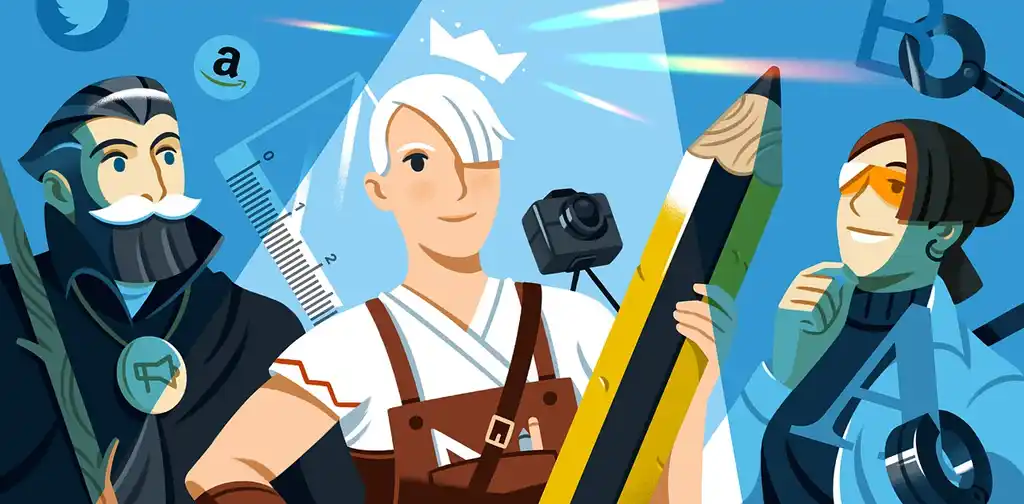
MEET THE BEST PUBLISHING PROFESSIONALS
Polish your book with expert help
Sign up to browse 2000+ experienced editors, designers, and marketers.
Should you choose Lulu Press?
Lulu produces fairly high-quality print books, but its distribution services leave a great deal to be desired. If you're only printing with them, you should be fine — but distributing your Lulu-printed books might get messy.
And if you’re still conflicted over whether or not to choose Lulu, here are our recommendations in the plainest terms possible!
✅ You should choose Lulu Press if:
- You want to order a small number of print books for yourself; and/or
- You’d like quality print books for your readers and don’t really care about profits.
That said, you can get even better quality printed books with Blurb, as long as you don't mind a slightly higher printing cost per unit. And if you really want to pull out all the stops, look into offset printing — there's a high upfront cost, as you have to order lots of copies at once, but the quality is unparalleled.
❌ You should not choose Lulu Press if:
- You want to actually make money through print book sales;
- You’re planning to distribute an ebook rather than a print book; and/or
- You’re in need of other services such as editing and design.
For some users, Lulu’s print production quality makes up for what it lacks in other areas. But we’d stress the importance of looking into all your options for POD before you commit— don’t go with Lulu just because they showed up when you Googled “publish a book”. By staying informed, you can ensure that you make the best print-on-demand decision for yourself, your readers, and, ultimately, your career as an author.
Reedsy rating: 1/5
